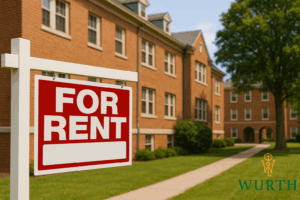There is a moment in every landlord’s life when they stare at their inbox and realize the applications have slowed to a trickle. Not stopped. Just… slowed. And that small dip is enough to make anyone a little uneasy. Because a rental only works if people want to live in it. Regularly. Predictably. Ideally without you begging the universe for one solid applicant who actually reads the listing.
The thing is, attracting tenants at scale is rarely about luck. It feels like luck sometimes, since people tend to apply in waves. Yet behind every building that never seems to sit empty is a system. A boring, reliable, sometimes repetitive system. A few repeating steps that quietly keep applications flowing in month after month.
If you can get that system working, twenty or more new tenant leads monthly stops sounding ambitious. It becomes normal. A rhythm you start to trust.
And honestly, trusting the rhythm might be the real relief.
The Reality Check: Tenants Have More Power Than Ever
Before diving into how to attract new tenants consistently, you have to accept something that stings a little. Renters have options. Too many options in some markets. The days of posting a listing and watching applications rain down like confetti are fading. The landscape is shifting toward renter preference and renter leverage. You can feel it everywhere if you pay attention.
The dynamic becomes even clearer when you look at wider patterns, like the tension described in The Great Tenant Shortage of 2025. When good renters hold all the power, the landlords who win are the ones who adapt early and stay flexible enough to keep that tenant flow moving.
If you want steady applications, you can’t bank on the past. You build the future. One consistent step at a time.
Step 1: Make Your Listing Worth Reading
A lot of landlords treat listings like grocery lists. Two bedrooms, one bath, dishwasher. Great, but that is not a pitch. Renters scroll. Renters skim. Renters look for something that feels like a real place where they can imagine living.
If the listing reads flat, the applications will be flat.
A strong listing focuses on clarity, a little personality, and a few details people genuinely care about. Not poetic prose. Not theatrical exaggeration. Just simple human-focused notes that help someone imagine how their life fits inside the space.
This is where having a well organized rental application system for landlords starts working quietly in the background. The easier the system is to use, the more the listing can focus entirely on making someone want to click in the first place.
Step 2: Keep Your Unit Photo-Ready Most of the Time
You do not need magazine-perfect photos. But clean, bright, and honest photos go a long way. Renters can tell when corners are being hidden. They can also tell when a property is cared for, even if it is simple.
There is always some conversation around what actually increases applications and what simply drains your budget without reward. It helps to understand the bigger picture, like the patterns shown in smart home features that actually increase rent. Some upgrades are flashier than they are useful. Others quietly boost your listing’s appeal without you needing to oversell them.
A photo of a clean, functional, modern lock will do more than a paragraph of adjectives.
Step 3: Make Applying Easy Enough That People Don’t Give Up
Half of attracting more applicants is removing the friction that pushes them away. Most renters decide within minutes whether they will complete an application. If your form is too long, too confusing or too glitchy on mobile, you lose good people fast.
A clean rental application system for landlords helps avoid that problem. The goal is to let someone start and finish an application during a short break at work or while waiting in the car during school pickup. Quick matters.
And yes, you still need screening. Just not the labyrinth version of it.
Step 4: Respond Faster Than Your Competition
Speed is probably the most underrated advantage in increasing tenant applications property management teams already understand deeply. It shows respect. It reduces uncertainty. It makes people feel like their application is genuinely being considered.
If a potential tenant has to wait four days for a reply, you already lost them to someone who replied in four minutes. Even a simple message like, “We received your application and will review it shortly” helps reduce the fear that their effort vanished into a void.
Property managers tend to outperform here because they build systems for response time. They are trained to move quickly. You do not need to be a full-time manager to adopt that mindset. Just check in consistently and answer sooner than later.
Step 5: Maintain Your Property Like Someone Is Moving In Tomorrow
It is surprising how often the lack of applications has nothing to do with marketing and everything to do with repairs. People can read between the lines. A loose outlet cover in one photo suggests other issues they will discover later. One messy wall shadow hints at a paint job that was never done right.
Deferred maintenance scares people off faster than high rent.
There is long-term evidence for this too. It shows up in discussions about why addressing the maintenance backlog problem is so important for ROI. When repairs pile up, applications dip, and turnover grows. It is a predictable cycle, and it is expensive.
Fix the small things. They are never small to renters.
Step 6: Use Multiple Listing Platforms, But Keep Your Voice Consistent
Zillow alone will not save you. Nor will Facebook groups. Nor will any single platform. Renters search in scattered ways, so you show up in scattered places. And even though it takes extra time, you make sure your message looks like the same property speaking.
People feel reassured when the information matches everywhere. It builds an unspoken sense of reliability.
A quick rule of thumb. If someone can find your listing on three different platforms and nothing contradicts anything else, you are doing it right.
Step 7: Keep a Reserve Flow of Mildly Interested Renters
The truth is, not everyone who applies will actually move forward. A lot of people apply before they decide they even want the place. Some apply while still exploring other options. Some apply out of hope, not certainty.
That is why steady volume matters. A reliable stream of applications means you never depend on just one person landing the final signature.
This approach also protects you during the months when interest dips, especially when conversations around topics like the rent vs buy decision in Baton Rouge become louder. When people get tempted to explore buying or alternative options, you need enough inquiries in rotation to balance the slow periods.
Think of it like having a healthy cushion. It does not make you immune to slowdowns. It just keeps you from panicking.
Step 8: Offer Something Small That Feels Big
Not a discount. Not a gimmick. Just one thing that feels like a genuine advantage. Maybe it is flexible move-in dates. Maybe it is a simplified approval process for well qualified renters. Maybe it is digital access to documents. People appreciate small friction-lifters more than you think.
You do not need grand gestures. You need one thoughtful thing that makes your property feel easier to apply for.
It’s very similar to the idea behind renter loyalty perks that keep good people longer. It is the emotional convenience that matters most. A sense that you are easy to work with.
Why Property Managers Often Outperform Individual Landlords
A good property manager is not magical. They just follow systems relentlessly. It is not glamorous. Sometimes it is repetitive. But it works.

When managers attract twenty or thirty new tenant leads monthly, it is largely because:
- They maintain listings like clockwork.
- They answer inquiries faster than anyone else.
- They standardize application flow so every renter gets the same smooth path.
- They keep properties in ca onstant move-in-ready condition.
And honestly, the consistency is what most landlords struggle with. Not the knowledge. The rhythm. The weekly and monthly steps that keep the machine running.
Property managers are built for that rhythm.
Putting It All Together: The Real Formula
Attracting 20+ new applicants every single month is not about perfect marketing or luck. It is about layers. Small optimizations stacked on other small optimizations. A few habits repeated enough times to become automatic.
It looks something like this:
- Create a listing someone actually wants to read.
- Show the unit honestly.
- Make the application effortless.
- Respond quickly.
- Keep the property maintained.
- Show up on multiple platforms.
- Give people one tiny but meaningful reason to choose you.
Do these on repeat. Month after month.
If you keep the cycle going, the applications follow you like clockwork.
If you want help setting up a system like this, we would be glad to support you. At Wurth Property Management, we focus on creating predictable, steady application flow for landlords who are tired of guessing. You are always welcome to reach out and see how we can help.
FAQs
1. What is the most important step in attracting consistent rental applications?
A: The biggest factor is reducing friction in your application process. When applying is easy, tenants follow through.
2. How often should listings be updated?
A: Every few weeks is ideal, especially if the market is competitive or interest slows down.
3. Do professional photos really make a difference?
A: Clear, clean photos help renters feel confident. They do not need to be studio level, but they should be bright and accurate.
4. How do property managers increase tenant applications more effectively?
A: They use consistent systems, fast response times, and ongoing property upkeep to keep inquiries steady.
5. Does offering perks or incentives work?
A: Small, practical conveniences work better than discounts. People appreciate anything that reduces stress during the move-in process.







